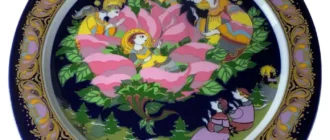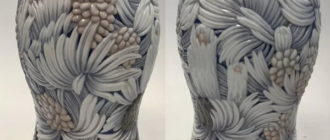
Sevres porcelain from the first days was created with the support of King Louis XV. This porcelain manufactory is one of the leading in Europe, also because its task was to produce high-quality tableware and interior decorations from the very beginning.
In subsequent years, the factory was owned by the crown, and now Sevres porcelain is produced under the control of the French Ministry of Culture. Over the 280-year history of the masters of Sevres, they have created many masterpieces from hard and soft porcelain.

History of the Sèvres porcelain in the 18th and 19th centuries
Porcelain from the Sevres factory first appeared in the early 1750s, although the manufactory began operations in 1740 in Vincennes. The first examples of production were exquisite white biscuit sculptures. Louis XV used these figures as diplomatic gifts, spreading the fame of decorative French porcelain.
In 1756, production is transferred to a new large building in Sevres, built on the initiative of Madame de Pompadour. Since the 1770s, the assortment of the factory has been replenished with elegant products made of hard porcelain. It began to be produced after the discovery of the French kaolin deposit. Around the same period, the previously dominant Rococo style in sculpture was replaced by neoclassicism.

In the first half of the 19th century
Sèvres porcelain was improved under the guidance of Alexandre Brongniart, a chemist and professor of mineralogy. Under him, hard porcelain became the main direction of production, new mixtures were developed, and the color palette was updated. During this period, many intricate, richly decorated items were created and distributed throughout the royal courts of Europe. Brongniard also founded the Museum of Ceramics, which has now become one of the largest in the world.

In the second half of the 19th century, production was modernized again. New furnaces were built, two of which are still in operation today. They are kindled on special occasions, for example, to celebrate anniversaries. The artistic style of this period is characterized by eclecticism. Masters are inspired by samples of Antiquity and Renaissance, not forgetting about classicism and rococo. Huge vases and services were created with scenes of Napoleon’s military victories. The art of Japanese and Chinese porcelain is also studied.

The Sevres manufactory in the 20th century and today
By the end of the 19th century, Sevres porcelain no longer aroused the same delight at exhibitions. The new director Alexandre Sandier decided in 1900 to develop the Art Nouveau style. The factory refuses outdated forms and bronze elements, softened the palette, and produced smaller products. The Art Deco style that developed in the 1920s was also reflected in Sèvres porcelain. The result is a triumph at the International Exhibition of Decorative Arts in 1925.

During the Second World War, the factory worked for the needs of the occupiers and was seriously damaged by the bombing of the British army, the purpose of which was the nearby Renault plant. Display cases with specimens, windows and an entire wing of the building were destroyed. 8,000 valuable items were damaged. Restoration began in 1948. In the 1970s and 80s, a new generation of painters and sculptors created unique porcelain in line with contemporary art trends.
Creative experiments continue to this day, including with the participation of invited artists. Some examples of modern sculpture created at the Sevres manufactory are kept in the best museums in the world. The factory regularly organizes thematic exhibitions and participates in contemporary art festivals. In 2012, she received the title of “living heritage” of France.

Here are the names of several artists who collaborated with the manufactory at different times:
- Jean-Jacques Bachelier (Jean-Jacques Bachelier);
- Cornelis van Spaendonck;
- Jules-Clément Chaplain;
- Serge Poliakoff;
- Louise Bourgeois.
The mission of the Sevres manufactory has remained unchanged since 1740. Its masters still create unique works of art by hand – inventing new ones and repeating old masterpieces.
Sèvres Porcelain Gallery











































